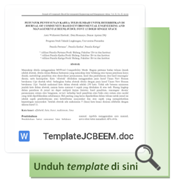Effect of Storage Time and Temperature on Drinking Water Characteristics
DOI:
https://doi.org/10.23969/jcbeem.v7i2.7854Keywords:
Drinking water, pH, turbidity, total coliforms, filter membranes, storageAbstract
Filter membrane technology is known to remove turbidity, colour and microorganisms in water. However, the stability of these parameters during storage is still being determined. This research was conducted to determine changes in pH, turbidity, and total coliform of water treated using membrane filter technology and stored at room temperature and in the refrigerator. Water stored at room temperature increases the pH more easily during storage time. On the other hand, there was no significant difference between changes in the turbidity value of water stored at room temperature and in the refrigerator. Closed storage at room temperature and refrigerators can also protect water from the growth of total coliform. Water treated using membrane filter technology is proven to be stored at room temperature or in the refrigerator without experiencing significant changes in pH, turbidity, and total coliform.
Downloads
References
Awfa, D., Yuniati, Y., & Prayogo, W. (2022). Efektifitas Penambahan Tanah Diatom sebagai Koagulan Tambahan untuk Menyisihkan Kekeruhan pada Air Terkontaminasi Alga. J. Tek. Ling. Lah. B. 10 (1), 121-128.
Hasrianti, H., & Nurasia, N. (2016). Analisis warna, suhu, ph dan salinitas air sumur bor di Kota Palopo. Pros. Sem. Nas. Univ. Cokroaminoto Pal. 2 (1), 747-753.
Moreira, V. R., Lebron, Y. A. R., Santos, L. V. de S., & Amaral, M. C. S. (2021). Dead-end ultrafiltration as a cost-effective strategy for improving arsenic removal from high turbidity waters in conventional drinking water facilities. Chem. Eng. J., 417, 128132.
Nie, Y., Wang, Z., Zhang, R., Ma, J., Zhang, H., Li, S., & Li, J. (2021). Aspergillus oryzae, a novel eco-friendly fungal bioflocculant for turbid drinking water treatment. Separat. & Puri.Tech., 279, 119669.
Park, W. il, Jeong, S., Im, S. J., & Jang, A. (2020). High turbidity water treatment by ceramic microfiltration membrane: Fouling identification and process optimization. Env. Tech. & Innov., 17, 100578.
Peng, C., Yan, X., Wang, X., Huang, Y., Jiang, L., Yuan, P., & Wu, X. (2021). Release of odorants from sediments of the largest drinking water reservoir in Shanghai: Influence of pH, temperature, and hydraulic disturbance. Chemos., 265, 129068.
PERMENKES. (2010). Peraturan Menteri Kesehatan Republik Indonesia No 492/Menkes/ Per/1v/2010 Tentang Persyaratan Kualitas Air Minum, (492). Tentang Persyaratan Kualitas Air Minum No 49.
Pramesti, D. S., & Puspitakawati, S. I. (2020). Analisis Uji Kekeruhan Air Minum dalam Kemasan Yang Beredar di Kabupaten Banyuwangi. J. Kes. Masy. 11 (1), 75-85.
Purwanti, A., Yusuf, M., Prayogo, W., & Ambarita, U. A. (2022). Penentuan Koefisien Transfer Massa Padat Cair Pada Sistem Tawas Air Dengan Variasi Kecepatan Putaran Dan Diameter Pengaduk. Kurvatek. 7 (1), 63-70.
Rosita, N. (2014). Analisis kualitas air minum isi ulang beberapa depot air minum isi ulang (damiu) di Tangerang Selatan . J. Kim. Valen. 4 (2), 134-141.
Subroto, M., Prayogo, W., Soewondo, P., & Setiyawan, A. S. (2022). Organic Removal in Domestic Wastewater Using Anaerobic Treatment System-MBBR With Flow Recirculation Ratio and Intermittent Aeration. Indonesian J. Urb. & Env. Tech. 5 (3), 296-316,.
Shah, A., Arjunan, A., Baroutaji, A., & Zakharova, J. (2023). A review of physicochemical and biological contaminants in drinking water and their impacts on human health. Water Science and Engineering.
Wibowo, R. S., & Ali, M. (2019). Alat pengukur warna dari tabel indikator universal pH yang diperbesar bersasis mikrokontroler arduino. J. Edu. Elek. 3 (2), 99-109.
Prayogo, W., Siregar, J. P., Soewondo, P., Nasution, Z., Hanami, Z. A., Ikhwali, M. F., ... & Suryawan, I. W. K. (2023). The Investigation on Mineral Wool Performance as a Potential Filter to Remove TSS in Cikapayang River, East Jawa, Indonesia: 10.32526/ennrj/21/202200118. Env. & Natur. Res. J. 21 (1), 9-18.
Yao, J., Sun, S., Zhai, H., Feger, K. H., Zhang, L., Tang, X., … Wang, Q. (2022). Dynamic monitoring of the largest reservoir in North China based on multi-source satellite remote sensing from 2013 to 2022: Water area, water level, water storage and water quality. Ecol. Indic. 144, 109470.
Zikra, W., Amir, A., & Putra, A. E. (2018). Identifikasi bakteri escherichia coli pada air minum di rumah makan dan cafe di kelurahan jati serta jati baru kota padang. J. Kes. Andal. 7 (2), 212-216.
Zhang, S., Tian, Y., Guo, Y., Shan, J., & Liu, R. (2021). Manganese release from corrosion products of cast iron pipes in drinking water distribution systems: Effect of water temperature, pH, alkalinity, SO42− concentration and disinfectants. Chemos. 262, 127904.














